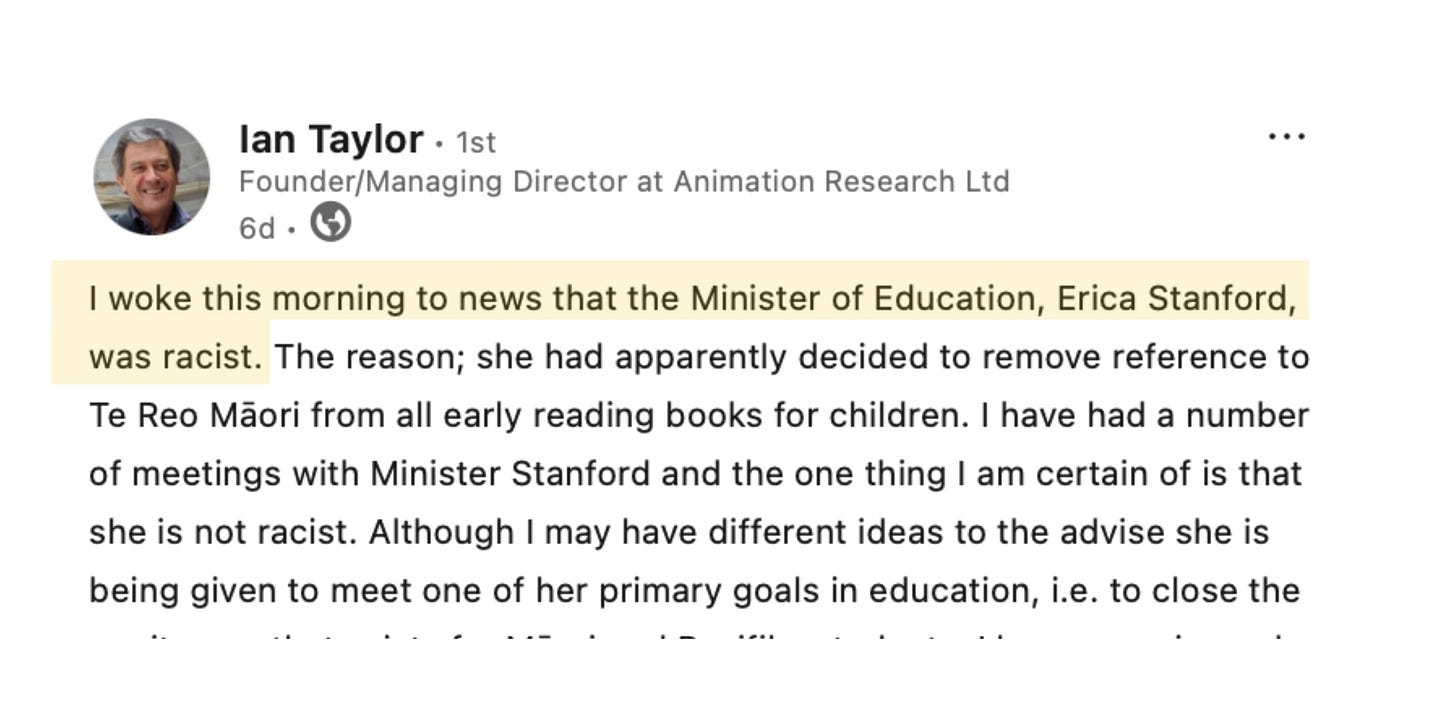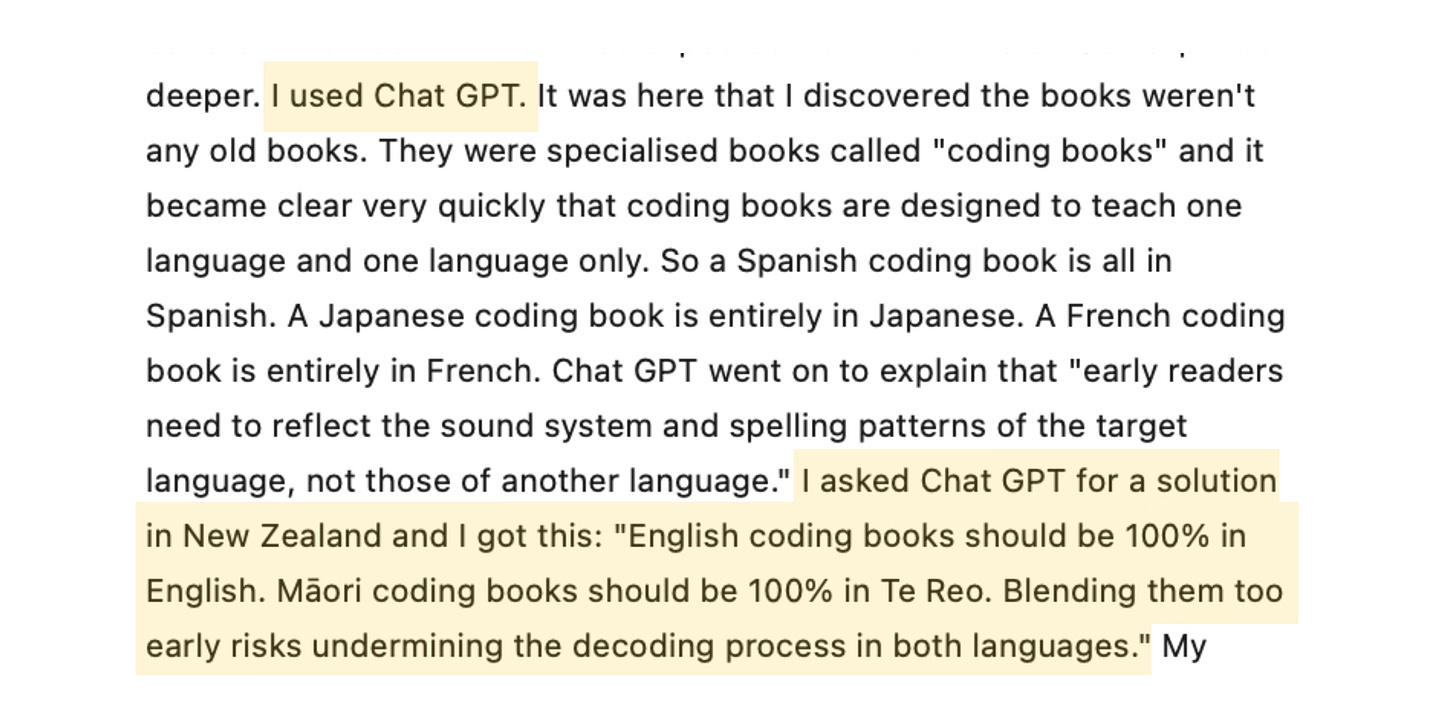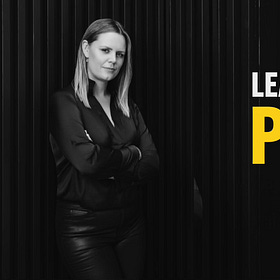"Isms" are not people
Does calling people racist protect racist systems? Maybe.
Racism and sexism do not live inside people, they are embedded in systems: patterns of language, policy, and power.
The response to the Ministry of Education decision to remove Māori words from early readers’ books shows how personal insults can distract from structural critique.
Racist. Sexist. Bigoted. Homophobic. Misogynistic. Classist. Ageist. Ableist.
Few people will consider themselves any of the above. Indeed, few people reading this are any of these things. These labels, which provoke instant defence and outrage, are personal insults, character assassinations. Racism, sexism and classism exist - but the ‘isms’ aren’t in people. They’re in patterns of intersecting and reinforcing language, decisions, rules and relationships. That is to say: they live in systems.
Those systems are not disrupted when we point fingers at one another - if anything, they’re reinforced.
Pundits and personal defences
In a LinkedIn post I saw this week, Ian Taylor wades into the discussion about removing Te Reo words from early readers’ books in the New Zealand primary school curriculum. He is outraged the Minister of Education has been called racist and comes to her personal defence.
The post, and the comments pouring forth, highlight a critical distinction about how structural forces like racism operate.
When we focus on individuals and their decisions, the debate gets personal. It becomes “Is Stanford racist?” rather than “Does this policy reinforce marginalisation of Māori?” The second question is arguably the one that matters, but our political discourse gets stuck on the first.
Institutions hide behind individuals
This is emblematic of modern outrage culture and the internet more broadly. I’m as quick as anyone to get incensed at the old tweets of a public figure or scowl at off-colour jokes. But collectively, we are slow to challenge the broader systems supporting those ideas.
The coverage of this decision was pointedly personal. Article after article begins with “Minister Stanford’s decision to…”, personalising a policy which, if one believes the Ministry, is the result of a "collaborative review process involving literacy experts, educators, and cultural advisors."
By calling it "Stanford's decision," the media:
Personalises a systemic process - making it about individual judgment rather than institutional patterns
Obscures the machinery - we don't hear about how "collaborative processes" work, whose voices get heard or excluded, whether they are tested or peer-reviewed, or what assumptions are made.
Creates the perfect deflection opportunity - Stanford can defend her personal intentions while the system that produced the recommendation stays invisible.
When Stanford is the face of a system, it distracts the conversation and lets everyone else off the hook. The bureaucrats who developed the policy, the "experts" who advised it, the institutional culture that made it feel reasonable all become invisible. This is how systems maintain themselves: by making structural processes look like individual choices and redirecting our attention.
The question isn't whether she's a good person, but whether the system she's working in produces outcomes that align with our values.
This work is free. If you value and can afford to support independent social and political critique, your paid support keeps it that way. Become a paid subscriber now.
OK but is it racist, though?
We can’t tell if this policy decision reflects an "act of racism," and "determined act to recolonize," as Te Akatea president Bruce Jepsen alleges, or an innocent move to make resources more “developmentally appropriate, culturally responsive, and aligned with the principles of structured literacy” as the Ministry of Education states, by looking at how racist people believe the Minister to be.
It's entirely possible that this decision reflects both genuine literacy concerns AND systemic bias. These aren't mutually exclusive. A good person can participate in a biased system - in fact, that's usually how bias operates. It doesn't require bad intentions, just inherited assumptions and processes that haven't been examined.1
To examine a system, we need to understand:
The pattern of decisions made in education, language, and biculturalism. Is this part of a broader trend? In which direction? What can we infer from this pattern? What biases are we bringing to that inference?
How different parts of the system work together. What rules determine how teachers, policymakers and experts interact? What relationships exist between schools, the ministry, and iwi? Who is involved in the crafting of advice or recommendations, the scoping of that work, and the resourcing of it? Who makes which decisions, and why?
The power dynamics involved. Who benefits from the status quo? Who would benefit from change? Who has the most resources, status or representation? Who has the least? How do these choices reinforce or shift that?
The purpose of change - legislative, political, or otherwise. What are we trying to achieve? Which goals have been prioritised in this context? Why those? Who set the tone on that?
The perception of reality being supported or disrupted. Which stories are being told and what meaning is made? What message does this send, to who? How will this be interpreted by different groups and stakeholders?
Whether you support the Ministry’s decision or oppose it, we probably agree that education policy should be evidence-based, inclusive, and effective. The systemic approach asks: are our policy-making processes designed to achieve those outcomes? Are we hearing from the right experts? Are we measuring success in ways that serve all our children?
When we locate individual choices inside these patterns and dynamics, we get a better picture of the invisible architecture. Whether the decisions to change reading books is racist has little to do with how Minister Stanford personally feels about Māori, and a lot to do with how New Zealand’s education system operates more broadly.
This 2020 NZCER research report shows that racism in New Zealand schools operates systematically. The researchers explicitly distinguish between "racism" (embedded in power structures and systems) and "racial prejudice" (interpersonal bias), arguing that conflating the two protects racist structures by "redirecting the focus away from addressing racism to, for example, the discomfort of dominant group individuals."
The evidence is stark: there is systemic racial bias in New Zealand education. Māori students receive consistently lower teacher judgements even when their standardised test scores match other students, creating "an underlying systematic bias within the New Zealand education system."
There has been some excellent reporting in the media that nods to many of these systemic factors. In particular, patterns of cultural erasure feature in much of the later, less reactive coverage.
In a media release from NZEI Te Riu Roa, Ripeka Lessels points to a pattern of decision-making, and ties it to a broader inferred purpose: “This is just the latest decision by the Government that tells us English comes first and Māori language and culture is dispensable.”(emphasis mine.) She doubles down on the purpose argument further, by saying: ““The excuse is it's too confusing or challenging for kids to decode reo Māori words but this is to justify the real goal of downgrading te reo Māori and Te Tiriti from education.” (emphasis mine.)
In an article from 1 News, academics speak to a pattern of policies demonstrating such a downgrade. For example, the Te Ahu o Te Reo programme, offering free lessons to teachers to better integrate te reo Māori in the classroom, helped 10,000 teachers learn Te Reo, had it’s budget cut in 2024 “despite a glowing independent review commissioned by the ministry.”
Principals’ Federation president Leanne Otene echoes this sentiment in comments to RNZ: “It’s not just one book, it’s part of a concerning pattern of removing te reo Māori [Māori language] from government services across the board,” she said. “Our children are growing up watching their government treat te reo Māori as less important.”
The Minister, conversely, claims this is part of a different pattern - one that is taking a more evidence-based and structured approach to addressing New Zealand’s declining literacy levels. However, according to The Guardian, Ministry reports dating back to the October 2024 assert that the evidence on competing orthographies having a negative impact on children’s learning are “mixed” and “uncertain.”
Conversely, commentators linking this decision to a broader pattern of this government’s “assault on te reo Maori” have no shortage of examples to points to, including:
“cuts to te reo Māori teacher training, mandating English-first in public service naming and communication, the disestablishment of Te Aka Whai Ora (Māori Health Authority), reversal of co-governance reforms, and undermining local Māori representation. The coalition also supported the Treaty Principles Bill, pushed by ACT, which aimed to enshrine fixed principles of the Treaty and extend these to all New Zealanders, effectively diluting Māori-specific rights.”
- Quote from Amanda Gillies’ article on RNZ
AI could make this worse
Taylor was transparent about how he had reached his views on the matter. Having read the media coverage, he consulted ChatGPT to try and understand the Ministry’s decision. His commitment to going beyond ad hominem attacks and inflammatory headlines to understand the reasoning behind policy decisions is laudable.
But this style of research - heading off to AI for an explanation - is a risky strategy.
ChatGPT is a black box trained on exactly the biases we’re trying to evaluate. AI systems like ChatGPT are not thinking, reasoning machines. They are built on everything that’s ever been put online - including the worst bits. Using ChatGPT to try and understand sensitive issues like structural racism is a terrible idea. When Taylor asks ChatGPT whether removing Te Reo words is racist, he's asking a mirror of existing exclusionary patterns to reflect back whether those patterns are problematic. And what do you think it will say?
AI’s answers and analysis are not neutral, nor are they going to be critical or original. The system cannot see beyond its own training data. The answers you receive from ChatGPT support and entrench the status quo, because a language model produces its answers based on statistical probability2.
Using ChatGPT is also a hamstring on new and innovative approaches (like, say, a world-leading approach to early reading that builds hard-coded biculturalism and bilingualism) because it doesn’t know what hasn’t already happened.
Forming your views from a word-stringing machine, rather than listening to the voices of academics, experts and cultural commentators is quick, but it’s not going to create anything new.
Critical thinking is not enough. It's time you learned about power.
Critical thinking is more important than ever. But it’s not enough to combat the impending wave of gullibility.
Racist red herrings
Overall, I agree with Taylor: the debate about whether a minister is racist is unhelpful. Focusing on the personal obscures the systemic, enabling structural forces to burrow away and hide. Policies, and people, can certainly be discriminatory in and of themselves, but the bigger question is how these choices reinforce or disrupt existing systemic patterns.
Systems create racism - with patterns of language, decisions, rules and relationships. Research suggests this is certainly true of the New Zealand education system. Dismantling these biases, should that be a goal of the Ministry, or the government, will require viewing policy decisions through this systemic lens.
For when it feels like you can't change anything
There’s always someone else to blame for why everything sucks.
So, how do we change it?
Systemic change is a bit like how your Grandad might fix a broken toaster - first, pull it apart, and see what all the parts do and how they fit together. Then, identify which bits need to change (and how they work together differently) to get a better result.
Once we have traced the architecture of power, and we understand who benefits from things being the way they are, we can start to dismantle the systems and stories that support it. The most meaningful and lasting change, driven from any point in a system, is caused by redefining the purpose of a system, and/or transforming the relationships within it.
Purpose questions, in this case, might interrogate target outcomes, performance frameworks, role definition. What is the education system designed to do? Produce robots, students, workers, or citizens? What kind of values, lessons and beliefs are we teaching our children? What do we consider a successful education? How do we check if it’s working? What is the role of the Ministry in enabling these outcomes?
If we point the system toward producing globally-minded, locally-proud, compassionate, informed, critical-thinking, historically-grounded citizens, that’s what we’ll get. If we design a system to produce robotic fact-peddlers who’ll work a bullshit job for low pay, that’s what we’ll get.
Relationship questions, in this case, might target consultative procedures, expert advisory panels, Ministry-school and school-community connections, participation in global communities, and the power dynamics between different forms of knowledge. Who sits on these expert panels? What qualifications are valued? How are Māori educators and knowledge holders positioned relative to "literacy experts"? When the Ministry conducts its "collaborative review process," who leads, who follows, and who isn't even in the room?
These relationship patterns - who has authority, whose knowledge counts, who is considered credible - shape every decision before the work even starts on a recommendation, much less a decision is made. Change these, and we will change the shape of education.
A better question to ask
Personal attacks on individuals (racist/not racist) are not just unhelpful. They’re actively protective of racist systems, because they redirect energy away from structural critique. Moving from 'Is Stanford racist?' to 'How do our systems work?' isn't changing sides - it's asking better questions that might lead to solutions everyone can support. These are tricky questions, because they ask things of us, like: what do we want? Who are we? Who do we want our children to be?
When we outsource our critical thinking to ChatGPT - a system trained on our biases - or reduce structural problems to personal failings, we perpetuate the patterns we claim to oppose.
The 'isms' aren't in people. They're in the spaces between us, in the rules we follow without thinking, and in the stories we tell about why things are the way they are.
So next time you're tempted to call someone a something-ist, let’s ask:
“What system is being protected, when I make this about them?"
Til next week,
AM
If you like this essay, share it with others. If you’re a regular reader, and you can afford it, please become a paid subscriber.
Though if you’re looking for a good takedown of the technical explanation, I’d direct you to this excellent piece from Vini Olsen-Reeder, research fellow at Te Herenga Waka—Victoria University of Auckland.
(If powerful people were designing a power-entrenching machine, this is exactly how they might do it.)








